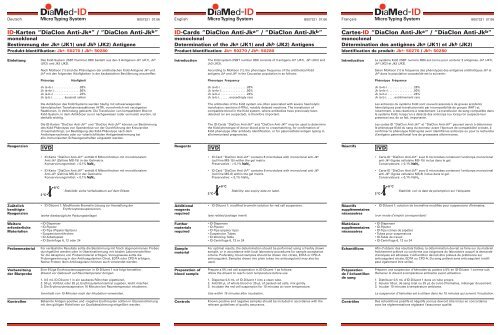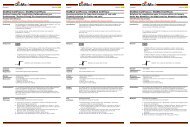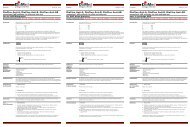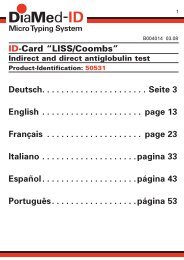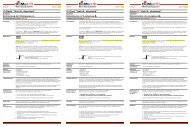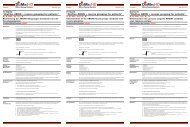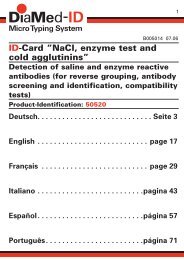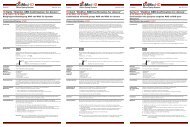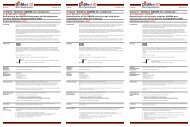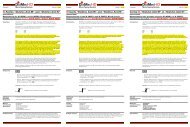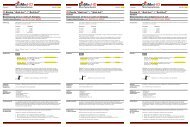ID-Karten “DiaClon Anti-Jka” / “DiaClon Anti-Jkb” ID-Cards “DiaClon ...
ID-Karten “DiaClon Anti-Jka” / “DiaClon Anti-Jkb” ID-Cards “DiaClon ...
ID-Karten “DiaClon Anti-Jka” / “DiaClon Anti-Jkb” ID-Cards “DiaClon ...
- No tags were found...
Create successful ePaper yourself
Turn your PDF publications into a flip-book with our unique Google optimized e-Paper software.
Deutsch B007321 07.06 English B007321 07.06 Français B007321 07.06<strong>ID</strong>-<strong>Karten</strong> <strong>“DiaClon</strong> <strong>Anti</strong>-Jk a ” / <strong>“DiaClon</strong> <strong>Anti</strong>-Jk b ”monoklonalBestimmung der Jka (JK1) und Jkb (JK2) <strong>Anti</strong>geneProdukt-Identifikation: Jk a : 50270 / Jk b : 50280<strong>ID</strong>-<strong>Cards</strong> <strong>“DiaClon</strong> <strong>Anti</strong>-Jk a ” / <strong>“DiaClon</strong> <strong>Anti</strong>-Jk b ”monoclonalDetermination of the Jka (JK1) and Jkb (JK2) <strong>Anti</strong>gensProduct-Identification: Jk a : 50270 / Jk b : 50280Cartes-<strong>ID</strong> <strong>“DiaClon</strong> <strong>Anti</strong>-Jk a ” / <strong>“DiaClon</strong> <strong>Anti</strong>-Jk b ”monoclonalDétermination des antigènes Jka (JK1) et Jkb (JK2)Identification de produit: Jk a : 50270 / Jk b : 50280EinleitungDas Kidd-System (ISBT Nummer 009) besteht aus den 3 <strong>Anti</strong>genen Jk a (JK1), Jk b(JK2) und Jk3 (JK3).IntroductionThe Kidd system (ISBT number 009) consists of 3 antigens Jk a (JK1), Jk b (JK2) andJk3 (JK3).IntroductionLe système Kidd (ISBT numéro 009) est connu pour contenir 3 antigènes, Jk a (JK1),Jk b (JK2) et Jk3 (JK3).Nach Mollison [1] sind die Phänotypen der antithetischen Kidd-<strong>Anti</strong>gene Jk a undJk b mit den folgenden Häufigkeiten in der kaukasischen Bevölkerung anzutreffen:According to Mollison [1], the phenotype frequency of the antithetical Kiddantigens Jk a and Jk b in the Caucasian population is as follows:Selon Mollison [1] la fréquence des phénotypes des antigènes antithétiques Jk a etJk b dans la population caucasoïde est la suivante:PhänotypHäufigkeitPhenotype FrequencyPhénotype FréquenceJk (a+b-) . . . . . . . . . . . . . . . .26%Jk (a+b+). . . . . . . . . . . . . . . .50%Jk (a-b+) . . . . . . . . . . . . . . . .24%Jk (a-b-). . . . . . . äusserst seltenDie <strong>Anti</strong>körper des Kidd-Systems werden häufig mit schwerwiegendenhämolytischen Transfusionsreaktionen (HTR), vornehmlich mit verzögertenReaktionen, in Verbindung gebracht. Die Transfusion von kompatiblem Blut imKidd-System, in dem <strong>Anti</strong>körper zuvor nachgewiesen (oder vermutet) wurden, istdeshalb wichtig.Die <strong>ID</strong>-<strong>Karten</strong> <strong>“DiaClon</strong> <strong>Anti</strong>-Jk a ” und <strong>“DiaClon</strong> <strong>Anti</strong>-Jk b ” können zur Bestimmungdes Kidd-Phänotyps von Spenderblut vor der Durchführung der Kreuzprobe(Crossmatching), zur Bestätigung des Kidd-Phänotyps nach dem<strong>Anti</strong>körpernachweis oder zur väterlich/fötalen <strong>Anti</strong>genbestimmung beiallo-immunisierten Schwangerschaften eingesetzt werden.Jk (a+b-) . . . . . . . . . . . . . . . .26%Jk (a+b+) . . . . . . . . . . . . . . . .50%Jk (a-b+) . . . . . . . . . . . . . . . .24%Jk (a-b-) . . . . . . exceedingly rareThe antibodies of the Kidd system are often associated with severe haemolytictransfusion reactions (HTRs), notably delayed reactions. The transfusion ofcompatible blood in the Kidd system, where antibodies have previously beendetected (or are suspected), is therefore important.The <strong>ID</strong>-<strong>Cards</strong> <strong>“DiaClon</strong> <strong>Anti</strong>-Jk a ” and <strong>“DiaClon</strong> <strong>Anti</strong>-Jk b ” may be used to determinethe Kidd phenotype of donor blood prior to crossmatching, for confirmation ofKidd phenotype after antibody identification, or for paternal/fetal antigen typing inalloimmunised pregnancies.Jk (a+b-) . . . . . . . . . . . . . . . .26%Jk (a+b+) . . . . . . . . . . . . . . . .50%Jk (a-b+) . . . . . . . . . . . . . . . .24%Jk (a-b-) . . . . . extrêmement rareLes anticorps du système Kidd sont souvent associés à de graves accidentshémolytiques post-transfusionnels par incompatibilité de groupe (RHT) et,notamment, à des réactions à retardement. La transfusion de sang compatible dansle système Kidd, lorsqu’on a détecté des anticorps (ou lorsqu’on suspecte leurprésence) est, de ce fait, importante.Les cartes-<strong>ID</strong> <strong>“DiaClon</strong> <strong>Anti</strong>-Jk a ” et <strong>“DiaClon</strong> <strong>Anti</strong>-Jk b ” peuvent servir à déterminerle phénotype Kidd du sang du donneur avant l’épreuve de compatibilité croisée, àconfirmer le phénotype Kidd après avoir identifié les anticorps ou pour la recherched’antigène paternel/foetal lors de grossesses alloimmunes.ReagenzienReagentsRéactifs• <strong>ID</strong>-Karte <strong>“DiaClon</strong> <strong>Anti</strong>-Jk a ” enthält 6 Mikroröhrchen mit monoklonalem<strong>Anti</strong>-Jk a (Zellinie MS-15) in der Gelmatrix.Konservierungsmittel: < 0,1% NaN 3 .• <strong>ID</strong>-Karte <strong>“DiaClon</strong> <strong>Anti</strong>-Jk b ” enthält 6 Mikroröhrchen mit monoklonalem<strong>Anti</strong>-Jk b (Zellinie MS-8) in der Gelmatrix.Konservierungsmittel: < 0,1% NaN 3 .• <strong>ID</strong>-Card <strong>“DiaClon</strong> <strong>Anti</strong>-Jk a ” contains 6 microtubes with monoclonal anti-Jk a(cell line MS-15) within the gel matrix.Preservative : < 0,1% NaN 3 .• <strong>ID</strong>-Card <strong>“DiaClon</strong> <strong>Anti</strong>-Jk b ” contains 6 microtubes with monoclonal anti-Jk b(cell line MS-8) within the gel matrix.Preservative: < 0,1% NaN 3 .• Carte-<strong>ID</strong> <strong>“DiaClon</strong> <strong>Anti</strong>-Jk a ” avec 6 microtubes contenant l’anticorps monoclonalanti-Jk a (lignée cellulaire MS-15) inclus dans le gel.Conservateurs: < 0,1% NaN 3 .• Carte-<strong>ID</strong> <strong>“DiaClon</strong> <strong>Anti</strong>-Jk b ” avec 6 microtubes contenant l’anticorps monoclonalanti-Jk b (lignée cellulaire MS-8) inclus dans le gel.Conservateurs: < 0,1% NaN 3 .Stabilität: siehe Verfallsdatum auf dem Etikett.Stability: see expiry date on label.Stabilité: voir la date de péremption sur l’étiquette.ZuätzlichbenötigteReagenzien• <strong>ID</strong>-Diluent 1: Modifizierte Bromelin-Lösung zur Herstellung derErythrozytensuspensionen.(siehe diesbezügliche Packungsbeilage)Additionalreagentsrequired• <strong>ID</strong>-Diluent 1: modified bromelin solution for red cell suspension.(see related package insert)Réactifssupplémentairesnécessaires• <strong>ID</strong>-Diluent 1: solution de broméline modifiée pour suspensions d’hématies.(voir mode d’emploi correspondant)WeitereerforderlicheMaterialien• <strong>ID</strong>-Dispenser• <strong>ID</strong>-Pipetor• <strong>ID</strong>-Tips (Pipetor-Spitzen)• Suspensionsröhrchen• <strong>ID</strong>-Arbeitsplatz• <strong>ID</strong>-Zentrifuge 6, 12 oder 24Furthermaterialsrequired• <strong>ID</strong>-Dispenser• <strong>ID</strong>-Pipetor• <strong>ID</strong>-Tips (pipetor tips)• Suspension Tubes• <strong>ID</strong>-Working Table• <strong>ID</strong>-Centrifuge 6, 12 or 24Matériauxsupplémentairesnécessaires• <strong>ID</strong>-Dispenser• <strong>ID</strong>-Pipetor• <strong>ID</strong>-Tips (cônes de pipette)• Tubes pour suspensions• <strong>ID</strong>-Table de travail• <strong>ID</strong>-Centrifuge 6, 12 ou 24ProbenmaterialFür verlässliche Resultate sollte die Bestimmung mit frisch abgenommenen Probendurchgeführt werden oder in Übereinstimmung mit lokalen Laborvorschriftenfür die Akzeptanz von Probenmaterial erfolgen. Vorzugsweise sollte dieProbengewinnung in den <strong>Anti</strong>koagulantien Citrat, EDTA oder CPD-A erfolgen.Native Proben (kein <strong>Anti</strong>koagulanz) können auch verwendet werden.SamplematerialFor optimal results, the determination should be performed using a freshly drawnsample, or in accordance with local laboratory procedures for sample acceptancecriteria. Preferably, blood samples should be drawn into citrate, EDTA or CPD-Aanticoagulant. Samples drawn into plain tubes (no anticoagulant) may also beused.EchantillonsAfin d’obtenir des résultats fiables, la détermination devrait se faire sur du matérielfraîchement prélevé ou conforme aux exigences du laboratoire auquel la demanded’analyses est adressée. L’échantillon devrait être prélevé de préférence suranticoagulant citrate, EDTA ou CPD-A. Du sang prélevé sans anticoagulant (natif)peut également être utilisé.Vorbereitungder BlutprobeEine 5%ige Erythrozytensuspension in <strong>ID</strong>-Diluent 1 wie folgt herstellen:Diluent vor Gebrauch auf Raumtemperatur bringen.1. 0,5 mL <strong>ID</strong>-Diluent 1 in ein sauberes Röhrchen pipettieren.2. 50 µL Vollblut oder 25 µL Erythrozytenkonzentrat zugeben, leicht mischen.3. Die Erythrozytensuspension 10 Minuten bei Raumtemperatur inkubieren.Preparation ofblood samplePrepare a 5% red cell suspension in <strong>ID</strong>-Diluent 1 as follows:Allow the diluent to reach room temperature before use.1. Dispense 0,5 mL of <strong>ID</strong>-Diluent 1 into a clean tube.2. Add 50 µL of whole blood or 25 µL of packed red cells, mix gently.3. Incubate the red cell suspension for 10 minutes at room temperature.Préparationde l’échantillonde sangPréparer une suspension d’hématies du patient à 5% en <strong>ID</strong>-Diluent 1 comme suit:Ramener le diluant à température ambiante avant utilisation.1. Distribuer 0,5 mL d’<strong>ID</strong>-Diluent 1 dans un tube propre.2. Ajouter 50 µL de sang total ou 25 µL de culot d’hématies, mélanger doucement.3. Incuber 10 minutes à température ambiante.Innerhalb von 15 Minuten nach der Inkubation verwenden.Use within 15 minutes after incubation.La suspension d’hématies est à utiliser dans les 15 minutes qui suivent l’incubation.KontrollenBekannte <strong>Anti</strong>gen-positive und -negative Erythrozyten sollten in Übereinstimmungmit den gültigen Richtlinien zur Qualitätssicherung mitgeführt werden.ControlsKnown positive and negative samples should be included in accordance with therelevant guidelines of quality assurance.ContrôlesDes échantillons positifs et négatifs connus devront être inclus en concordanceavec les réglementations régissant l‘assurance qualité.
Italiano B007321 07.06 Español B007321 07.06 Português B007321 07.06Schede <strong>ID</strong> <strong>“DiaClon</strong> <strong>Anti</strong>-Jk a ” / <strong>“DiaClon</strong> <strong>Anti</strong>-Jk b ”monoclonaleDeterminazione degli antigeni Jka (JK1) e Jkb (JK2)Identificazione prodotto: Jk a : 50270 / Jk b : 50280Tarjetas <strong>ID</strong>-Card <strong>“DiaClon</strong> <strong>Anti</strong>-Jk a ” / <strong>“DiaClon</strong> <strong>Anti</strong>-Jk b ”monoclonalDeterminacíon de los antígenos Jka (JK1) y Jkb (JK2)Identificacíon del producto: Jk a : 50270 / Jk b : 50280<strong>Cards</strong>-<strong>ID</strong> <strong>“DiaClon</strong> <strong>Anti</strong>-Jk a ” / <strong>“DiaClon</strong> <strong>Anti</strong>-Jk b ”monoclonalDeterminação dos antigénios Jka (JK1) e Jkb (JK2)Identificação do produto: Jk a : 50270 / Jk b : 50280IntroduzioneIl sistema Kidd (ISBT numero 009) è composto da 3 antigeni Jk a (JK1), Jk b (JK2) eJk3 (JK3).IntroducciónEl sistema Kidd (ISBT número 009) consta de 3 antígenos Jk a (JK1), Jk b (JK2) y Jk3(JK3).IntroduçãoO sistema Kidd (número ISBT 009) consiste em 3 antigénios, nomeadamente Jk a(JK1), Jk b (JK2) e Jk3 (JK3).Secondo Mollison [1], la frequenza del fenotipo degli antigeni Kidd antitetici Jk a eJk b nella popolazione di razza caucasica è la seguente:Según Mollison [1], la frecuencia fenotípica de los antígenos Kidd antitéticos Jk a yJk b en la población caucásica es la siguiente:Segundo Mollison [1], a frequência do fenótipo dos antigénios antitéticos de KiddJk a e Jk b na população caucasiana é a seguinte:FenotipoFrequenzaJk (a+b-) . . . . . . . . . . . . . . . .26%Jk (a+b+) . . . . . . . . . . . . . . . .50%Jk (a-b+) . . . . . . . . . . . . . . . .24%Jk (a-b-) . . . . estremamente raroGli anticorpi del sistema Kidd sono spesso associati a gravi reazioni emolitichetrasfusionali (HTRs), specie di tipo ritardato. E' pertanto importante effettuare latrasfusione di sangue compatibile per il sistema Kidd nel caso in cui in precedenzasia stata individuata (o sospettata) la presenza di anticorpi.Le schedine <strong>ID</strong> <strong>“DiaClon</strong> <strong>Anti</strong>-Jk a ” e <strong>“DiaClon</strong> <strong>Anti</strong>-Jk b ” possono essere utilizzateper determinare il fenotipo Kidd del sangue del donatore prima della prova dicompatibilità (crossmatching), per la conferma del fenotipo Kidd dopol'identificazione degli anticorpi o per la tipizzazione dell'antigene paterno/fetalenelle gravidanze alloimmunizzate.FenotípFrecuenciaJk (a+b-) . . . . . . . . . . . . . . . .26%Jk (a+b+) . . . . . . . . . . . . . . . .50%Jk (a-b+) . . . . . . . . . . . . . . . .24%Jk (a-b-) . .extremadamente raroA menudo, los anticuerpos del sistema Kidd están asociados a reaccioneshemolíticas post-transfusionale (RHT) de carácter grave, generalmente retardadas.Por lo tanto, resulta importante la transfusión de sangre compatible en el sistemaKidd cuando se hayan detectado anticuerpos previamente (o se sospeche suexistencia).Las tarjetas <strong>ID</strong>-Card <strong>“DiaClon</strong> <strong>Anti</strong>-Jk a ” y <strong>“DiaClon</strong> <strong>Anti</strong>-Jk b ” pueden emplearsepara determinar el fenotipo Kidd de la sangre de un donante antes de pruebascruzadas, confirmar el fenotipo Kidd después de la identificación de anticuerpos, opara la determinación de antígenos paternos/fetales en embarazos aloinmunizados.FenótipoFrequênciaJk (a+b-) . . . . . . . . . . . . . . . .26%Jk (a+b+). . . . . . . . . . . . . . . .50%Jk (a-b+) . . . . . . . . . . . . . . . .24%Jk (a-b-). . . . extremamente raraOs anticorpos do sistema Kidd estão frequentemente associados a graves reacçõeshemolíticas pós-transfusionais (HTRs), nomeadamente com reacções tardias. Porconseguinte, é importante a transfusão de sangue compatível no sistema Kiddquando forem detectados anticorpos (ou quando a sua presença é suspeita).Os <strong>Cards</strong>-<strong>ID</strong> <strong>“DiaClon</strong> <strong>Anti</strong>-Jk a ” e <strong>“DiaClon</strong> <strong>Anti</strong>-Jk b ” podem ser utilizados paradeterminar o fenótipo Kidd do sangue do dador antes do teste de compatibilidade,para confirmação do fenótipo Kidd após identificação do anticorpo ou para atipagem de antigénios materno/fetais em caso de gravidez aloimune.ReagentiReactivosReagentes• Schedina <strong>ID</strong> <strong>“DiaClon</strong> <strong>Anti</strong>-Jk a ” con 6 microprovette contenenti nella matrice delgel anticorpi anti-Jk a monoclonale (linea cellulare MS-15).Conservante: < 0,1% NaN 3 .• La tarjeta <strong>ID</strong>-Card <strong>“DiaClon</strong> <strong>Anti</strong>-Jk a ” contiene 6 microtubos con anti-Jk amonoclonal (línea celular MS-15) en la matriz de gel.Conservante: < 0,1% NaN 3 .• Card-<strong>ID</strong> <strong>“DiaClon</strong> <strong>Anti</strong>-Jk a ” com 6 microtubos contendo anti-Jk a monoclonal(clone MS-15) no gel.Conservante: < 0,1% NaN 3 .• Schedina <strong>ID</strong> <strong>“DiaClon</strong> <strong>Anti</strong>-Jk b ” con 6 microprovette contenenti nella matrice delgel anticorpi anti-Jk b monoclonale (linea cellulare MS-8).Conservante: < 0,1% NaN 3 .• La tarjeta <strong>ID</strong>-Card <strong>“DiaClon</strong> <strong>Anti</strong>-Jk b ” contiene 6 microtubos con anti-Jk bmonoclonal (línea celular MS-8) en la matriz de gel.Conservante: < 0,1% NaN 3 .• Card-<strong>ID</strong> <strong>“DiaClon</strong> <strong>Anti</strong>-Jk b ” com 6 microtubos contendo anti-Jk b monoclonal(clone MS-8) no gel.Conservante: < 0,1% NaN 3 .Stabilità: vedere la data di scadenza sull'etichetta.Estabilidad: véase fecha de caducidad en la etiqueta.Estabilidade: ver prazo de validade no rótulo.Altrireagentioccorrenti• Diluente <strong>ID</strong> 1: soluzione modificata di bromelina per la preparazione disospensioni di eritrociti.(consultare la relativa scheda tecnica)Reactivosadicionalesnecesarios• <strong>ID</strong>-Diluent 1: solución de bromelina modificada para suspensión de eritrocitos.(véase el prospecto correspondiente)Reagentesadicionaisnecessários• <strong>ID</strong>-Diluent 1: solução de bromelina modificada para suspensão de eritrócitos.(ver folheto informativo correspondente)Altrimaterialioccorrenti• Dispensatore <strong>ID</strong>• Pipettatore <strong>ID</strong>• Puntali <strong>ID</strong> (puntali per pipettatore)• Provette per sospensione• Stazione di lavoro <strong>ID</strong>• Centrifuga <strong>ID</strong> 6, 12 o 24Otrosmaterialesnecesarios• <strong>ID</strong>-Dispenser• <strong>ID</strong>-Pipetor• <strong>ID</strong>-Tips (puntas para pipeta)• Tubos de suspensión• <strong>ID</strong>-Working table (superficie de trabajo)• <strong>ID</strong>-Centrifuge (centrífuga) 6, 12 o 24Outrosmateriaisnecessários• <strong>ID</strong>-Dispenser• <strong>ID</strong>-Pipetor• <strong>ID</strong>-Tips (pontas para pipetador)• Tubos de Suspensão• <strong>ID</strong>-Working table• <strong>ID</strong>-Centrifuge 6, 12 ou 24CampioniPer ottenere risultati attendibili, si consiglia di eseguire la determinazione su uncampione fresco o conforme alle procedure del laboratorio per i criteri diaccettazione dei campioni. I campioni devono essere prelevati preferibilmente incitrato, EDTA o CPD-A. Si possono comunque usare anche campioni prelevati inprovette normali (senza anticoagulante).MuestrasPara un resultado óptimo, la determinación debe realizarse con una muestra reciénextraída, o cumpliendo la normativa local del laboratorio en cuanto a criterios deaceptabilidad de las muestras. Preferiblemente, las muestras de sangre debenrecogerse utilizando citrato, EDTA o CPD-A como anticoagulante. También esposible utilizar muestras recogidas en tubos sin anticoagulante.AmostrasPara obtenção dos resultados ideais, a determinação deve ser realizada numaamostra recentemente colhida, ou em conformidade com os critérios de aceitaçãodo procedimento laboratorial local. As amostras de sangue devem, de preferência,ser colhidas em anticoagulante citrato, EDTA ou CPD-A. Também é possível utilizaramostras colhidas em tubos limpos (sem anticoagulante).Preparazionedel campionePreparare una sospensione di eritrociti al 5% in diluente <strong>ID</strong> 1 nel modo seguente:Portare il diluente a temperatura ambiente prima dell’uso.1. Pipettare 0,5 mL di diluente <strong>ID</strong> 1 in una provetta pulita.2. Aggiungere 50 µL di sangue intero o 25 µL di emazie concentrate, mescolaredelicatamente.3. Incubare la sospensione di eritrociti per 10 minuti a temperatura ambiente.Preparación dela muestra desangrePrepare una suspensión de eritrocitos al 5% en <strong>ID</strong>-Diluent 1 del modo siguiente:Deje que el diluyente alcance la temperatura ambiente antes de utilizarlo.1. Pipetee 0,5 mL de <strong>ID</strong>-Diluent 1 en un tubo limpio.2. Añada 50 µL de sangre total o 25 µL de sedimento de hematies y agitesuavemente.3. Incube la suspensión de eritrocitos durante 10 minutos a temperatura ambiente.Preparaçãoda amostra desanguePrepare uma suspensão de eritrócitos a 5% em <strong>ID</strong>-Diluent 1 do seguinte modo:Antes de utilizar, deixe o diluente atingir a temperatura ambiente.1. Dispense 0,5 mL de <strong>ID</strong>-Diluent 1 num tubo limpo.2. Adicione 50 µL de sangue total ou 25 µL de concentrato de eritrócitos, misturesuavemente.3. Incube a suspensão de eritrócitos durante 10 minutos à temperatura ambiente.Utilizzare entro 15 minuti.Utilice en los 15 minutos posteriores a la incubación.Utilize até 15 minutos após incubação.ControlliSi consiglia di includere sempre controlli noti positivi e negativi in accordo con ledirettive in vigore per la garanzia di qualità.ControlesDeben incluirse muestras positivas y negativas conocidas de acuerdo con lasnormas de garantía de calidad aplicables.ControlosAmostras positivas e negativas conhecidas devem ser incluídas em conformidadecom as directrizes relevantes para controlo da qualidade.
Português B007321 07.06 Español B007321 07.06 Italiano B007321 07.06Procedimentodo testeNão usar <strong>Cards</strong>-<strong>ID</strong> que tenham sinais de secagem, bolhas, selos danificados, gotasde gel ou sobrenadante na parte superior dos microtubos ou na parte de baixo dapelícula de alumínio.Procedimientode la pruebaNo usar las <strong>ID</strong>-Tarjetas que muestren signos de desecación, burbujas en el gel,sellado defectuoso, gotas de gel o de sobrenadante en la parte superior de losmicrotubos o en la superficie interior del aluminio de sellado.ProceduraNon utilizzare <strong>ID</strong>-<strong>Cards</strong> che mostrano segni di disidratazione, bolle, pellicoledanneggiate, gocce di gel o surnatante nella parte superiore delle microprovette osotto la copertura di alluminio.Deixar os cards-<strong>ID</strong> atingir a temperatura ambiente antes de usar.Antes de usar dejar que las <strong>ID</strong>-tarjetas alcancen la temperatura ambiente.Portare le schede <strong>ID</strong> a temperatura ambiente prima dell‘uso.1. Identifique o microtubo apropriado do Card-<strong>ID</strong> <strong>“DiaClon</strong> <strong>Anti</strong>-Jk a ” e/ou <strong>“DiaClon</strong><strong>Anti</strong>-Jk b ” com o nome ou número do doente.2. Retirar a película de alumínio de todos os microtubos necessários segurando oCard-<strong>ID</strong> na posição vertical.3. Pipete 10 ou 12,5 µL de suspensão de eritrócitos para o microtubo apropriado.4. Centrifugue o Card-<strong>ID</strong> durante 10 minutos na <strong>ID</strong>-Centrifuge.5. Leia e anote os resultados.1. Marque el correspondiente microtubo de la tarjeta <strong>ID</strong>-Card <strong>“DiaClon</strong> <strong>Anti</strong>-Jk a ” o<strong>“DiaClon</strong> <strong>Anti</strong>-Jk b ” con el nombre o número del paciente.2. Retirar la lámina de sellado sólo de los microtubo que se vayan a utilizarmanteniendo la <strong>ID</strong>-Tarjeta en posición vertical.3. Pipetee 10 ó 12,5 µL de la suspensión de eritrocitos en el microtubocorrespondiente.4. Centrifugue la tarjeta <strong>ID</strong>-Card durante 10 minutos en la <strong>ID</strong>-Centrifuge.5. Lea y registre los resultados.1. Trascrivere sulla schedina <strong>ID</strong> <strong>“DiaClon</strong> <strong>Anti</strong>-Jk a ” e/o <strong>“DiaClon</strong> <strong>Anti</strong>-Jk b ” il nomeo il numero del paziente.2. Rimuovere la copertura di alluminio dalle microprovette da utilizzare, tenendo la<strong>ID</strong>-Card in posizione verticale.3. Pipettare 10 o 12,5 µL di sospensione di eritrociti nella microprovettaappropriata.4. Centrifugare la schedina <strong>ID</strong> per 10 minuti nella centrifuga <strong>ID</strong>.5. Leggere e annotare le reazioni.Interpretaçãodos resultadosA) Princípio [2]Positivo:Negativo:Eritrócitos aglutinados formando uma linha vermelha à superfíciedo gel ou aglutinados dispersos no gel.Botão compacto de eritrócitos no fundo do microtubo.Interpretaciónde losresultadosA) Principio [2]Positivo:Negativo:Los eritrocitos aglutinados forman una línea roja sobre la superficiedel gel o aparecen dispersos en el gel.Sedimento compacto de eritrocitos en el fondo del microtubo.Interpretazionedei risultatiA) Principio [2]Positivo:Negativo:Gli eritrociti agglutinati formano una linea rossa sul gel o sonodistribuiti nel gel.Sedimento compatto di eritrociti sul fondo della provetta.B) Reacções para Jk a e Jk bB) Reacciones para Jk a y Jk bB) Reazioni per gli antigeni Jk a e Jk b• Reacções positivas de + a ++++ indicam a presença do antigéniocorrespondente. As reacções intensas ++++ são muito raras.• O anti-Jka pode reagir mais fortemente com eritrócitos Jk (a+b-) do que comeritrócitos Jk (a+b+).• As reacções negativas indicam a ausência do antigénio correspondente.• Las reacciones positivas de + a ++++ indican la presencia del antígenocorrespondiente. Son poco frecuentes reacciones ++++ intensas.• El <strong>Anti</strong>-Jka puede reaccionar más intensamente con los hematíes homocigotosJk (a+b-) que con los hematíes heterocigotos Jk (a+b+).• Las reacciones negativas indican ausencia del correspondiente antígeno.• Una reazione positiva da + a ++++ indica la presenza dell'antigenecorrispondente. Le reazioni forti del tipo ++++ sono molto rare.• L‘anti-Jka può reagire più intensamente con emazie Jk (a+b-) che con emazieJk (a+b+).• Una reazione negativa indica l'assenza dell'antigene corrispondente.Observações1. Antes de investigar a presença de antigénios, é necessário certificar-se de queos eritrócitos estão isentos de anticorpos que reajam a técnicas enzimáticas.2. A centrifugação repetida do Card-<strong>ID</strong> não afecta o desempenho do produto.Observaciones1. Antes de determinar la presencia de antígenos, hay que asegurar que loseritrocitos no presentan autoanticuerpos reactivos a las enzimas.2. El centrifugado repetido de la tarjeta <strong>ID</strong>-Card no afecta al comportamiento delproducto.Note1. Prima di effettuare le analisi per la presenza degli antigeni, assicurarsi che glieritrociti siano privi di autoanticorpi reattivi agli enzimi.2. La centrifugazione ripetuta della schedina <strong>ID</strong> non influisce sulle prestazioni delprodotto.Limitaçõesa) Os cards-<strong>ID</strong> que tenham bolhas de ar no gel ou gotas na parte superior dosmicrotubos e/ou no segmento de alumínio devem ser centrifugados antes deusar.b) A contaminação, bacteriana ou outra, dos materiais utilizados pode originarresultados falsamente positivos ou falsamente negativos.c) Resíduos de fibrinas na suspensão de eritrócitos podem reter eritrócitos nãoaglutinados, formando assim uma fina linha cor de rosa à superfície do gel, aopasso que a maior parte dos eritrócitos migra para o fundo do microtubo apóscentrifugação.d) O cumprimento estrito dos procedimentos e a utilização do equipamentorecomendado são essenciais. O equipamento deve ser regularmente verificadoem conformidade com os procedimentos de BPL (Boa Prática de Laboratório).e) A utilização de soluções de suspensão diferentes de <strong>ID</strong>-Diluent 1 pode alterar asreacções.f) Suspensões de eritrócitos demasiado concentradas ou demasiado diluidaspodem provocar resultados errados.Limitacionesa) Las <strong>ID</strong>-Tarjetas que muestren burbujas de aire en el gel o gotas en la partesuperior de los microtubos y/o de la lámina de sellado, deben ser centrifugadasantes de usarlas.b) La contaminación de los materiales empleados, bacteriana o de otro tipo, puedeprovocar falsos positivos o falsos negativos.c) Los restos de fibrina en la suspensión de eritrocitos pueden atrapar los hematíesno aglutinados, de modo que aparezca una fina línea rosada en la parte superiordel gel mientras que la mayoría de los eritrocitos se encuentran en el fondo delmicrotubo tras el centrifugado.d) Es esencial atenerse estrictamente a los procedimientos y equiposrecomendados. El equipo debe comprobarse periódicamente según la normativade buenos prácticas de laboratorio (GLP).e) El empleo de soluciones de suspensión distintas de <strong>ID</strong>-Diluent 1 puede modificarlas reacciones.f) Suspensiones de hématies muy concentradas o muy diluidas pueden causarresultados anórmalos.Limitazionia) Le <strong>ID</strong>-<strong>Cards</strong> che mostrano bolle d’aria nel gel o gocce nella parte superiore delmicropozzetto e/o sul foglio di alluminio, devono essere centrifugate primadell’uso.b) Le contaminazioni batteriche o di altro tipo del materiale utilizzato possonoessere causa di risultati falsamente negativi o positivi.c) Eventuali residui di fibrina nella sospensione di eritrociti possono incollare glieritrociti non agglutinati, che si mostrano quindi sotto forma di sottile linearosa sulla superficie del gel, mentre la maggior parte degli eritrociti dopocentrifugazione forma un sedimento compatto sul fondo della provetta.d) E' indispensabile seguire scrupolosamente le istruzioni e impiegare il necessariomateriale di lavoro. Il materiale di lavoro deve essere controllato regolarmentesecondo le direttive GLP.e) L'impiego di soluzioni diverse dal diluente <strong>ID</strong> 1 per le sospensioni di eritrocitipuò influire sulle reazioni.f) Una sospensione di eritrociti troppo concentrata o troppo diluita può causarereazioni anomale.Bibliografia1. Mollison, P.L., Engelfriet, C.P. und Contreras, M.: Blood Transfusion in ClinicalMedicine,10 th ed. 1997; Blackwell Scientific Publications, Oxford.2. Lapierre, Y., Rigal, D., Adam, J. et al.: The gel test: A new way to detect red cellantigen-antibody reactions. Transfusion 1990: 109-113.Bibliografía1. Mollison, P.L., Engelfriet, C.P. und Contreras, M.: Blood Transfusion in ClinicalMedicine,10 th ed. 1997; Blackwell Scientific Publications, Oxford.2. Lapierre, Y., Rigal, D., Adam, J. et al.: The gel test: A new way to detect red cellantigen-antibody reactions. Transfusion 1990: 109-113.Bibliografia1. Mollison, P.L., Engelfriet, C.P. und Contreras, M.: Blood Transfusion in ClinicalMedicine,10 th ed. 1997; Blackwell Scientific Publications, Oxford.2. Lapierre, Y., Rigal, D., Adam, J. et al.: The gel test: A new way to detect red cellantigen-antibody reactions. Transfusion 1990: 109-113.Produtos Card-<strong>ID</strong> <strong>“DiaClon</strong> <strong>Anti</strong>-Jk a ” 1 x 12 . . . . . . . . . . . . . .REF 007321Card-<strong>ID</strong> <strong>“DiaClon</strong> <strong>Anti</strong>-Jk b ” 1 x 12 . . . . . . . . . . . . . .REF 007331Estes produtos são garantidos quanto ao seu comportamento funcional, tal comodescrito no rótulo e no folheto informativo. O fabricante declina toda aresponsabilidade decorrente da utilização ou venda destes produtos para finsdiferentes dos aí descritos.Productos Tarjeta <strong>ID</strong>-Card <strong>“DiaClon</strong> <strong>Anti</strong>-Jk a ” 1 x 12 . . . . . . . . . . . . . .REF 007321Tarjeta <strong>ID</strong>-Card <strong>“DiaClon</strong> <strong>Anti</strong>-Jk b ” 1 x 12 . . . . . . . . . . . . . .REF 007331Se garantiza que estos productos se comportarán según lo descrito en la etiquetay en la hoja de instrucciones. El fabricante declina toda responsabilidad en caso deque los productos se utilicen o vendan para cualquier otro uso diferente de los allídescritos.Prodotti Scheda <strong>ID</strong> <strong>“DiaClon</strong> <strong>Anti</strong>-Jk a ” 1 x 12 . . . . . . . . . . . . . .REF 007321Scheda <strong>ID</strong><strong>“DiaClon</strong> <strong>Anti</strong>-Jk b ” 1 x 12 . . . . . . . . . . . . . .REF 007331Si garantiscono per questi prodotti le prestazioni descritte sull‘etichetta e nel fogliodi istruzioni. Il produttore declina ogni responsabilità derivante dall‘uso improprio odalla vendita di questi prodotti per scopi diversi da quelli qui descritti.0123 01230123DiaMed AG, 1785 Cressier s/Morat, Suíça DiaMed AG, 1785 Cressier s/Morat, Suiza DiaMed AG, 1785 Cressier s/Morat, Svizzera


